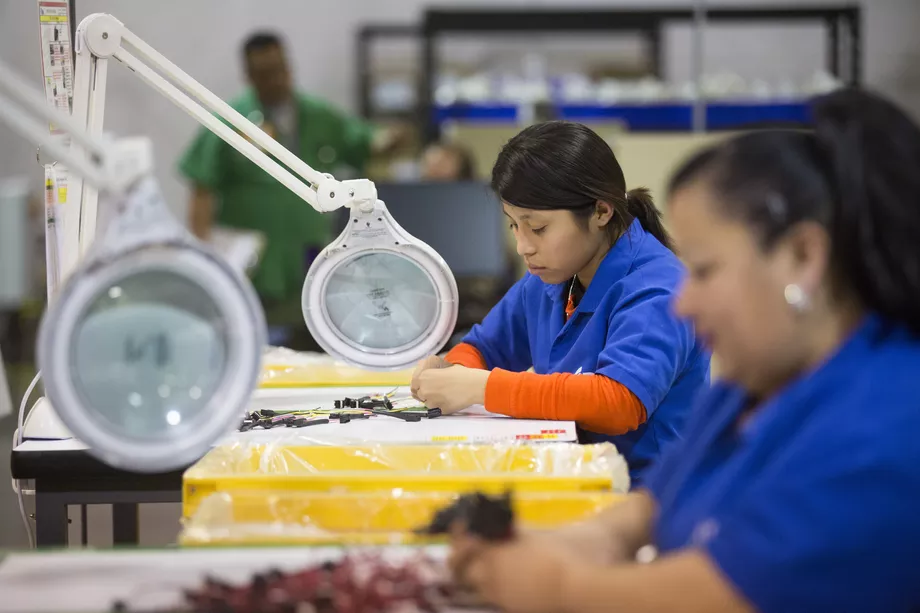The White House is finalizing details of a new free trade deal with Mexico to replace the North American Free Trade Agreement — with or without Canada.
Scrapping NAFTA was one of President Trump’s central promises during his presidential campaign. He blamed the 24-year-old trade pact for decimating the US manufacturing industry and the loss of thousands of factory jobs (NAFTA only played a small role in the decline of American manufacturing, but that’s another story). The 1994 trade deal allows North American goods to cross the US, Canadian, and Mexican borders tax-free, adding up to about $1.2 trillion in annual trade.
So far, the new United States-Mexico Trade Agreement seems a lot like NAFTA, though Canada has yet to opt in as it continues negotiations. Agricultural products would remain tariff-free under the new deal, and there is still no required renegotiation every five years (which Trump wanted). It would be harder, however, for businesses to claim harm from unfair trade practices.
But there is one striking difference from NAFTA: The new pact includes several labor rules meant to benefit workers on both sides of the border. For example, Mexico has agreed to pass a law giving workers the right to real union representation, and to adopt other labor laws that meet international standards set forth by the United Nations. American auto companies that assemble their cars in Mexico would also need to use more US-made car parts to avoid tariffs, which would help US factory workers. And about 40 percent of those cars would need to be made by workers earning at least $16 an hour — three times more than Mexico’s minimum wage.
NAFTA was not good for low-wage workers in Mexico or the United States
First of all, it’s important to note that free trade between the United States, Canada, and Mexico has had a small, but positive, impact on all three economies. That is something most economists can agree on. The controversy over NAFTA, which was enacted in 1994, involves its impact on workers. American labor unions worried at the time that allowing goods to cross the border untaxed would give US manufacturers too much incentive to move factories and jobs to Mexico, where wages were super low and environmental standards more relaxed.
Proponents of NAFTA pushed back against that idea, saying that boosting trade would raise wages for low-skilled Mexican workers, pulling millions out of poverty and making it less attractive for companies to move factories to Mexico. That definitely didn’t happen. Competition from US farms was largely responsible for putting more than 1 millionfarmworkers in Mexico out of work, and the unemployment rate in Mexico is higher today than it was back then.
On top of that, wages for workers in Mexico have hardly budged. Just look at this chart:
In the United States, NAFTA didn’t lower overall US wages, as some feared, but it was linked to lower wages in some manufacturing jobs. The trade deal was also directly responsible for the loss of more than 840,000 US factory jobs, most of which were moved to Mexico. Just last year, Ford announced it was closing one of its auto factories and opening another one in Mexico.
US companies are still doing this because factory workers in Mexico are still making poverty wages. And one reason workers in Mexico are still living in poverty is because NAFTA’s labor protections have not been enforced.
NAFTA was also supposed to protect workers, but it didn’t
When NAFTA was signed, it included labor protections for workers in all three countries. Basically, each country agreed to enforce its own labor laws and follow standards set by the UN’s International Labor Organization. But labor complaints filed through the NAFTA labor dispute process have led nowhere.
About two dozen complaints of workers’ rights violations were filed against all three countries in NAFTA’s first decade — the vast majority in Mexico, according to Human Rights Watch. Companies accused of violating local labor laws include General Electric, Honeywell, Sony, General Motors, McDonald’s, Sprint, and the Washington state apple industry.
In Mexico, those complaints included allegations of retaliation against workers who tried to unionize, denial of collective bargaining rights, forced pregnancy testing, mistreatment of migrant workers, and life-threatening health and safety conditions. None have led to any type of sanctions, which workers’ rights groups say is because there are no rules about how to resolve these disputes and government mediators have chosen to take a hands-off approach.
“Our research shows that agreements on labor will never work without the active support of the countries involved. In the case of NAFTA, these three countries have actually worked to minimize the impact of the labor provisions,” the report stated.
One of the biggest complaints against Mexico right now is that labor unions are largely controlled by employers, and workers are not even part of contract negotiations. So it’s no wonder why Mexican factory workers are earning so little. The average hourly wage for factory workers in Mexico is just over $2 an hour — and the country’s minimum wage is roughly $4.15 for a full day’s work. These low wages attract US companies to operate in Mexico.
The new labor rules in Trump’s pact with Mexico are supposed to remove the incentive to keep Mexican workers living in poverty. But it’s hard to picture how those rules would ever be enforced.

